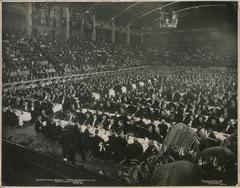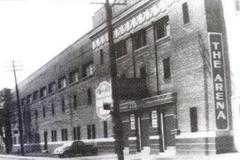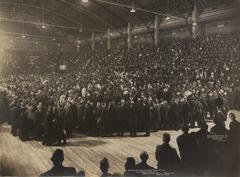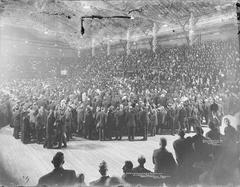
Mutual Street Arena Toronto: Visiting Guide, Historical Significance, and Nearby Attractions
Date: 14/06/2025
Introduction to Mutual Street Arena and Its Importance
Located in the heart of downtown Toronto, the former site of the Mutual Street Arena—originally Arena Gardens—stands as a powerful symbol of the city’s sporting and cultural evolution. Opened in 1912 as Ontario’s first artificial ice rink and Canada’s largest indoor arena at the time, it was instrumental in the development of professional hockey in Toronto. Early NHL teams, including the Toronto Arenas and St. Patricks (forerunners of the Toronto Maple Leafs), played here, and the arena hosted Toronto’s first Stanley Cup victory in 1918.
Beyond sports, the Mutual Street Arena was a hub for concerts, political rallies, and community events, featuring performances from legends like Glenn Miller and Frank Sinatra. Though the arena was demolished in 1989, its legacy endures through commemorative plaques, Arena Gardens Park, and the surrounding neighbourhood, making it a meaningful destination for history enthusiasts, sports fans, and visitors keen to connect with Toronto’s vibrant past.
This comprehensive guide covers the Mutual Street Arena’s historical impact, visitor information, accessibility, nearby attractions, and practical tips to enhance your experience. For further reading, consult reputable sources such as Mutual Street Arena - Wikipedia and Toronto History - Mutual Street Arena.
Historical Overview
Origins and Construction
The Mutual Street Arena was conceived in response to Toronto’s need for a large-scale public venue in the early 20th century. Built on the site of the former Caledonian Rink, its construction was overseen by Sir Henry Pellatt and the Toronto Arena Company, with designs by Ross and McFarland. When it opened in 1912, it was the largest indoor arena in Canada, featuring innovative artificial ice technology that enabled year-round skating and hockey.
Early Years and Sporting Significance
From its opening until 1931, the arena was the epicenter of professional and amateur hockey in Toronto. It hosted teams from the National Hockey Association and National Hockey League, including the Toronto Arenas and St. Patricks. The arena witnessed the city’s first Stanley Cup triumph in 1918, cementing its place in hockey history.
Multifunctional Venue
While hockey was central, the arena was designed for versatility. It hosted concerts, boxing, wrestling, cycling, tennis, and large community gatherings. This adaptability made it a focal point of Toronto’s social and cultural life throughout much of the 20th century.
Transition and Final Years
After Maple Leaf Gardens opened in 1931, the Mutual Street Arena transitioned into a recreational facility, offering roller skating, curling, and concerts. In 1962, a major renovation rebranded it as The Terrace, adding amenities like a restaurant and curling rink. Ultimately, the property was sold and demolished in 1989, making way for residential and park developments that commemorate its legacy.
Cultural and Sporting Significance
Birthplace of Professional Hockey in Toronto
The Mutual Street Arena was foundational to Toronto’s status as a hockey city. It was home to the Toronto Arenas—who won the Stanley Cup in 1918—and the St. Patricks, later rebranded as the Maple Leafs. Its artificial ice plant was the first of its kind in Ontario, and its capacity of 6,700 for hockey made it a national landmark (Toronto History - Mutual Street Arena).
Architectural and Social Innovation
Designed with unobstructed sightlines and excellent acoustics, the arena was Canada’s largest auditorium when it opened, suitable for both sporting and cultural events. Its $500,000 construction cost reflected the city’s ambition and positioned Toronto as a leader in modern arena design (Toronto History - Mutual Street Arena).
Entertainment and Civic Hub
The arena hosted not only elite sports but also musical performances, rallies, and community celebrations. From operatic acts and military bands to memorable prohibition rallies, its stage was shared by local and international performers, enhancing its role as a social and cultural landmark.
Urban Transformation and Legacy
After its closure, the site was redeveloped into Arena Gardens Park and the John Innes Community Recreation Centre, with commemorative plaques ensuring that the arena’s contributions to Toronto’s heritage are not forgotten (Toronto Parks).
Visiting Information: Arena Gardens Park and Site Details
Location and Accessibility
- Address: 78 Mutual Street, Toronto, ON
- Transit: Easily accessible via Dundas Station (TTC subway) and nearby streetcar/bus routes. Walking from Dundas Station takes approximately 10 minutes.
- Parking: Limited street parking is available on Mutual Street and nearby side streets; public parking lots can be found near Yonge-Dundas Square.
Visiting Hours and Admission
- Arena Gardens Park: Open daily from dawn to dusk; free admission.
- John Innes Community Recreation Centre: Typically open Monday to Friday, 6:00 AM–10:00 PM, and weekends 8:00 AM–8:00 PM. Check the City of Toronto Parks and Recreation website for current schedules.
- No tickets or reservations are required to visit the park or view commemorative plaques.
Site Features: What to See and Do
- Heritage Plaque: Read about the arena’s history at the City of Toronto Heritage Plaque near the park or recreation centre entrance (Toronto Heritage Plaques).
- Arena Gardens Park: Enjoy landscaped green space, benches, and walking paths—a peaceful spot for reflection or a picnic.
- John Innes Community Recreation Centre: Explore modern recreational facilities, continuing the site’s tradition of community activity.
- Photography: Capture the heritage plaque, park, and urban scenery for your records or social media.
Nearby Historical and Cultural Attractions
- Mackenzie House Museum: Historic home of Toronto’s first mayor.
- Maple Leaf Gardens: Iconic hockey venue, now featuring retail and an athletic centre.
- Allan Gardens Conservatory: A historic greenhouse with exotic plants.
- Yonge-Dundas Square: Public events, performances, and vibrant city life.
- St. Lawrence Market: Renowned market and heritage site with food stalls and artisan vendors.
Guided Tours and Self-Guided Walks
While there are no tours dedicated solely to the Mutual Street Arena, you can join Toronto heritage walking tours that include the site as part of broader explorations. Self-guided tours are easy using online resources or mobile heritage apps (Heritage Toronto Tours).
Visitor Tips
- Best Time to Visit: Spring and summer offer the most pleasant weather for exploring the park and nearby attractions.
- Accessibility: The park and recreation centre are wheelchair accessible, featuring paved paths and ramps.
- Amenities: Numerous cafes, restaurants, and shops are nearby, especially along Dundas Street East and Yonge Street.
- Etiquette: Be respectful of residents; avoid loud gatherings and leave the area as you found it.
Frequently Asked Questions (FAQ)
Q: Is the Mutual Street Arena still standing?
A: No, the arena was demolished in 1989. The site is now home to Arena Gardens Park and the John Innes Community Recreation Centre.
Q: Are there entrance fees or tickets required?
A: No, visiting the park and heritage plaque is free. Recreation centre programs may have specific fees.
Q: How do I get to the site by transit?
A: Take the TTC subway to Dundas Station and walk east; several streetcar routes also serve the area.
Q: Are guided tours available?
A: Not specifically for the arena, but some city walking tours include the site.
Q: Is the site accessible for visitors with disabilities?
A: Yes, the area features accessible sidewalks and facilities.
Visual and Interactive Resources
- Historic images: “Mutual Street Arena exterior, circa 1920”; “Interior view during a hockey game.”
- Current images: “Arena Gardens park entrance”; “Heritage plaque at former arena site.”
Additional Resources and Further Reading
- Mutual Street Arena - Wikipedia
- Taylor on History - Arena Gardens
- Toronto History - Mutual Street Arena
- Heritage Matters - A Night Out at the Gardens
- Toronto Parks - Arena Gardens Park
- Heritage Toronto Tours
- Ontario Away - Toronto Tourist Attractions
- Toronto For You - Top Attractions
Conclusion
Although the Mutual Street Arena no longer physically exists, its profound influence on Toronto’s sporting, social, and cultural life remains. Visitors to the site can enjoy the tranquil Arena Gardens Park, view commemorative plaques, and explore a neighbourhood rich in history. With excellent accessibility, nearby landmarks, and a blend of old and new, the Mutual Street Arena site is a rewarding destination for anyone interested in the city’s heritage.
To further enrich your experience, consider joining a walking tour, browsing local archives, or using apps like Audiala for guided audio tours of Toronto’s historic sites. Stay connected with Toronto’s living history—plan your visit today.
Sources and Further Reading:































































































































































































